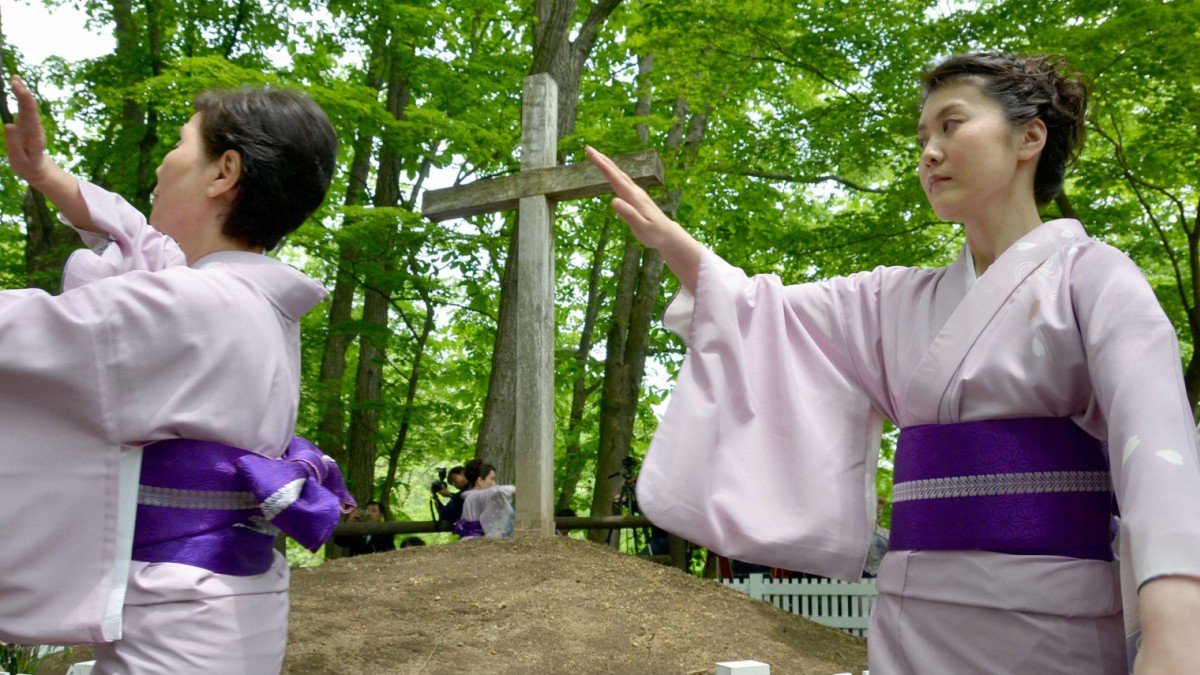Every year, thousands make a pilgrimage to the grave of a wandering herder who settled in a remote corner of northern Japan two millennia ago. He fathered three daughters with a farmer’s daughter named Miyuko and died at the biblical age of 106. In the mountain village of Shingo he is known as Daitenku Taro Jurai. The rest of the world knows him as Jesus Christ.
The town of 2,700 souls in Aomori Prefecture boasts a world sensation: It is called Kirisuto no Sato: “Home of Christ” https://www.sueddeutsche.de/reise/.”Even from a distance you can see two barrows on a hill “, noted the Japanese expert Maik Hendrik Sprotte (1964-2023). “They are particularly marked by two tall wooden crosses: the ‘Tomb of Christ’ and a tomb attributed to his brother Isukiri.” According to Japanese legend, he allowed himself to be crucified on Mount Golgotha in place of his brother. Isukiri’s grave contains only his ears and a supposed lock of hair belonging to the Virgin Mary. Christ carried these souvenirs with him during his adventurous escape.
Is the burial site a miracle, a fantastic intrigue or simply a scam?
The source of this tradition is a ten meter long scroll. It was discovered on May 26, 1936 by Kiyomaro Takeuchi (1875-1965), who claimed that it was nothing less than the “Testament of Christ.” He is said to have dictated it as he lay dying. It tells what is probably humanity’s greatest story: Jesus came to Japan at the age of 21 to study Shintoism. This happened during his “lost years”, the phase of his life about which nothing is written in the New Testament. He became a student of a great master near Mount Fuji, where he learned the Japanese language and Eastern culture. At the age of 33 he returned to Judea.
Even experts like Michiyo Miwa don’t have a clear answer as to how he managed to swap places on the cross with his younger brother. The president of the Society for the Study of the Takeuchi Documents suspects that Jesus swapped roles with his younger brother before his arrest in the Garden of Gethsemane, on the Mount of Olives in Jerusalem. Escaping crucifixion, after a four-year odyssey and countless hardships, he reached Alaska, took a ship and landed in the port of Hachinohe, in northeastern Japan. From there he traveled to the village of Herai, later Shingo. He settled down and took on a new identity. The will ends with the wish that he be buried on a hill near the village – next to a site for his memorabilia.
Takeuchi went searching and actually found two ancient tombs in Shingo that matched the description. Soon a myth surrounded this place. Pilgrims and tourists traveled particularly during the occultist boom in the 1970s. Today an estimated 20,000 visitors come every year, more than 30 percent of whom are foreigners.
The tourism authority has decided when the anniversary of his death will be celebrated
A highlight in spring is the “Christ Festival” (Kirisuto matsuri) to commemorate the anniversary of Jesus’ death. It was set by the tourism authority for May 3rd, although Jesus died on April 6th. But then there would still be too much snow and not enough tourists would come.
During the traditional “Bon” dance around the twin graves, women in kimonos chant a three-verse litany, the wording of which is said to contain traces of Hebrew. The local dialect also has Hebrew-sounding words, according to displays in the “Legend of Christ Museum”, where “Christ souvenirs” are sold, including a “Kirisuto” rice wine.
According to the museum information, residents used to wear clothing embroidered with a pattern that resembled a Star of David. It is also engraved on the old furniture of some families. Newborns had a black cross drawn on their foreheads. And in the event of a death, a cross marked the deceased’s house for three years. The original old village name Herai also goes back to an early diaspora from the Middle East. Some researchers even speculate that Shingo could have been settled by “descendants of the Ten Lost Tribes of Israel.”
(Foto: picture alliance/Associated Press)
Were “secret Christians” hiding when their religion was strictly banned in Japan? Are the Takeuchi Documents really 2,000 years old as Takeuchi claimed?
Although their authenticity is doubted and much of it was destroyed in the bombing of Tokyo in 1945, the surviving documents are considered an important contemporary document of the 1930s. “They can be embedded in the context of Japanese nationalism at the time,” explains Martin Lehnert. “They carry out a political-religious reinterpretation of Japanese prehistory and portray Jesus Christ as a part of the mythology of Japan,” says the professor of religion and philosophy of East Asia at Munich’s Ludwig Maximilians University (LMU).
“At a time when propaganda was emphasizing supposed Japanese superiority, these manuscripts were intended to show that Japan lies at the cultural roots of China and the West,” says historian Ryosuke Okamoto of Hokkaido University in his book “Pilgrimages in the Secular Age “.
In it he tries to understand how a place with a fake history could become a special place. It cannot claim any historical or scientific authenticity, which most visitors are aware of. Nevertheless, it has a great attraction. The trips to Shingo are an expression of individual religiosity in a modern society, says Okamoto. Many people feel spiritual power in this place. However, the Japanologist cannot really explain how this “sanctification of an ordinary place” came about. Shingo is “a prime example of a tourist spot that is obviously unpredictable.”
